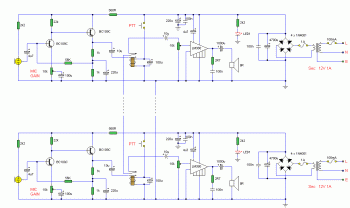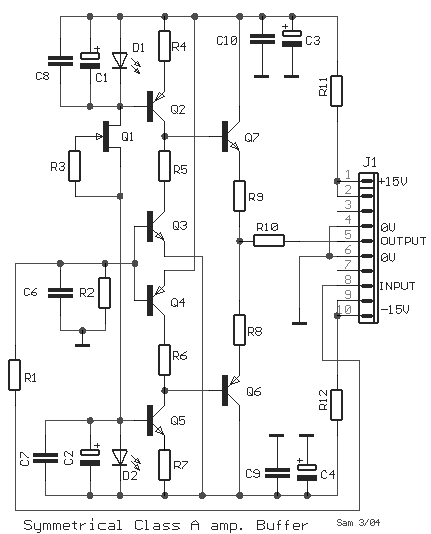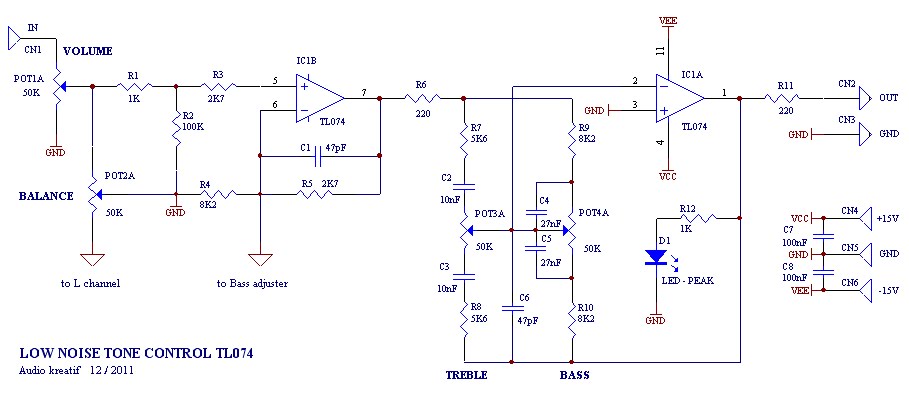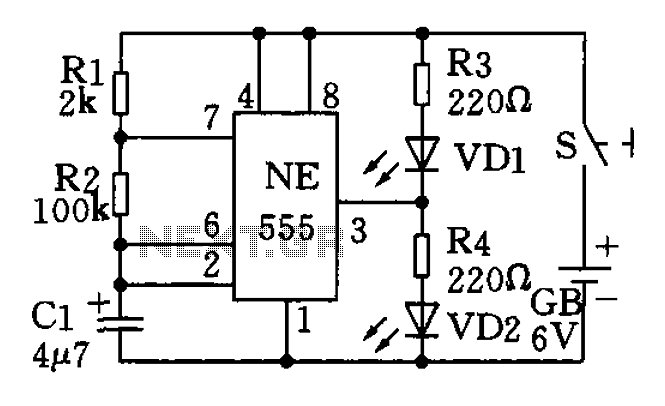
Circuit Project: Wireless Doorbell

It is a wireless doorbell with a cost of about $10.00. This product encourages a shift in approach to building projects, utilizing such items to learn about their functions and modify them to meet specific needs. The doorbell incorporates quality components and is not of inferior quality. The circuit design is impressive, with some components not readily available individually. The effectiveness of the device is remarkable. The clever circuitry is notable, as some design aspects contradict traditional electronics principles. This highlights the importance of studying other designs and acknowledging that increased knowledge often reveals further gaps in understanding. The oscillator circuit is particularly interesting, beginning with the RF oscillator. The doorbell operates on the 303 MHz band, achieving a range of 30 meters (100 feet) without an external antenna. The circuit radiates signals from the printed track of the tank circuit, which consists of a single-turn coil and a small capacitor (5pF and 4pF in parallel). The project demonstrates how to add a small antenna to the circuit to double the range, along with two additional enhancements to increase performance. Some modifications may load the circuit and alter its operating frequency, while others can be implemented without affecting the circuit. The transmitting stage is designed to be robust against stray capacitance. The circuit maintains proximity to the power rails using a choke in the positive rail, which is reflected to the negative rail through the battery. This design aids in antenna integration. A 7 cm length of tinned copper wire is connected to the transistor's collector and bent around the board to facilitate reassembly. Testing within the author's home showed a doubling of the range, and outdoors, the range exceeded 60 meters (200 feet), though the full range could not be tested due to the faint sound of the doorbell. Learning from commercially available products provides insights into reliability and cost-effective components. In this instance, the transmitting transistor is of high gain, indicating careful selection for quality. The transmitter circuit comprises two main components: the 303 MHz RF oscillator and the 32 kHz crystal-controlled oscillator. The 303 MHz oscillator consists of a self-oscillating circuit formed by the coil on the PCB and a 9pF capacitor (4pF and 5pF in parallel). The circuit initiates through noise generated by the transistor, with the resulting signal passed to the parallel tuned circuit (the tank circuit), allowing the base to receive a smooth sine wave at 303 MHz. This sine wave is amplified by the transistor, generating the desired frequency. The role of the 15 microhenry choke in the tank circuit is to manage current fluctuations during oscillation. The choke generates a back-emf that opposes current changes, creating a voltage at the connection point on the board. This enables the track work to produce a waveform, and due to the high frequency, a portion of the energy is radiated as electromagnetic energy.
The wireless doorbell circuit exemplifies innovative design principles, particularly in its RF transmission capabilities. The use of a self-oscillating circuit highlights the efficiency of integrating passive components like capacitors and inductors to create a resonant tank circuit. The choice of operating frequency at 303 MHz is strategic, as it balances range and component size, allowing for compact design without sacrificing performance.
The addition of an antenna is a significant enhancement, demonstrating how simple modifications can yield substantial improvements in range and signal clarity. The careful selection of components, particularly the high-gain transistor, not only ensures reliable transmission but also allows for a robust design that can withstand variations in environmental conditions.
Moreover, the choke's role in managing current fluctuations is crucial for maintaining oscillator stability. By mitigating the effects of back-emf, the circuit can sustain its operational frequency, ensuring consistent performance. The design's resilience against stray capacitance further underscores its sophistication, making it suitable for practical applications.
Overall, this wireless doorbell circuit serves as an educational platform, illustrating fundamental electronic principles while offering insights into practical circuit design and optimization. The ability to learn from existing products fosters a deeper understanding of electronics, encouraging experimentation and innovation in future projects.It is a wireless doorbell with a cost of about $10. 00. So, we have to change our attitude to building projects and use items such as this to learn how things work and modify them to suit our own requirements. This doorbell uses quality components. It`s not rubbish. The circuit is quite unbelievable. You can not obtain some of the components individually and the effectiveness is magic. We have so much to learn! The first thing you will notice is the clever circuitry. Some of the design goes against everything we have learnt in electronics. That`s why we have to study other people`s designs and realise the more you know, the more you realise you don`t know. The oscillator circuit is very interesting, but first we will look at the RF oscillator. The doorbell operates on the 303MHz band and the 30 metre range (100ft) is obtained without the use of an antenna!
The circuit is actually radiating from the printed track of the tank circuit. The Tank Circuit is a single-turn coil and a small capacitor (5p & 4p in parallel). In this project we show how to add a small antenna to the circuit to get double the range plus two other improvements to increase the range. Some of the improvements will load the circuit and alter the frequency at which it operates. Others can be done without any effect on the circuit. Fortunately, the transmitting stage is what we call tight and is not affected by surrounding stray capacitance.
The circuit has been kept near the power rails by the use of a choke in the positive rail. The positive rail is then reflected to the negative rail via the battery. This feature helps us when we want to add an antenna. A 7cm length of tinned copper wire is connected to the collector of the transistor and bent around the board so that everything can be put back into the case. When the project was tested inside the authors house, the range was increased to double. When the transmitter was taken outside, the range was over 60 metres (200ft) and the full range could not be tested as the sound from the doorbell was too faint to be heard!
We can learn so much from a product that is already on the market. Firstly, you know it works, it is reliable and you know what can be built for $10. 00. Secondly, you know what type of components can be purchased cheaply and what to expect from them. In this case the transmitting transistor has the highest gain so they have taken a special effort to get a good quality transistor. Now, let`s look at the transmitter circuit: The transmitter circuit is made up of two building blocks the 303MHz RF oscillator and the 32kHz crystal controlled oscillator.
The 303MHz oscillator consists of a self-oscillating circuit made up of the coil on the PC board and a 9p (9 puff) capacitor (actually 4p and 5p in parallel). The circuit starts-up by the transistor producing noise. This rising-and-falling signal on the collector is passed to the parallel tuned circuit (the tank circuit) and the base sees a very smooth sinewave at a frequency of 303MHz.
This sinewave is then amplified by the transistor and this is how the 303MHz frequency is generated. Now we come to the purpose of the 15microhenry choke on the tank circuit. When the circuit oscillates, it takes a larger and small amount of current. . This current passes through the choke and the turns produce a back-emf or back voltage that fights against the flow (change) in current. The end effect is a voltage created at the point where the choke is connected to the track-work on the board.
This effectively allows the track work to produce a waveform and since the frequency of this wave is very high, a percentage of the energy is radiated into the air as electromagnetic energy. The choke allows the 🔗 External reference
The wireless doorbell circuit exemplifies innovative design principles, particularly in its RF transmission capabilities. The use of a self-oscillating circuit highlights the efficiency of integrating passive components like capacitors and inductors to create a resonant tank circuit. The choice of operating frequency at 303 MHz is strategic, as it balances range and component size, allowing for compact design without sacrificing performance.
The addition of an antenna is a significant enhancement, demonstrating how simple modifications can yield substantial improvements in range and signal clarity. The careful selection of components, particularly the high-gain transistor, not only ensures reliable transmission but also allows for a robust design that can withstand variations in environmental conditions.
Moreover, the choke's role in managing current fluctuations is crucial for maintaining oscillator stability. By mitigating the effects of back-emf, the circuit can sustain its operational frequency, ensuring consistent performance. The design's resilience against stray capacitance further underscores its sophistication, making it suitable for practical applications.
Overall, this wireless doorbell circuit serves as an educational platform, illustrating fundamental electronic principles while offering insights into practical circuit design and optimization. The ability to learn from existing products fosters a deeper understanding of electronics, encouraging experimentation and innovation in future projects.It is a wireless doorbell with a cost of about $10. 00. So, we have to change our attitude to building projects and use items such as this to learn how things work and modify them to suit our own requirements. This doorbell uses quality components. It`s not rubbish. The circuit is quite unbelievable. You can not obtain some of the components individually and the effectiveness is magic. We have so much to learn! The first thing you will notice is the clever circuitry. Some of the design goes against everything we have learnt in electronics. That`s why we have to study other people`s designs and realise the more you know, the more you realise you don`t know. The oscillator circuit is very interesting, but first we will look at the RF oscillator. The doorbell operates on the 303MHz band and the 30 metre range (100ft) is obtained without the use of an antenna!
The circuit is actually radiating from the printed track of the tank circuit. The Tank Circuit is a single-turn coil and a small capacitor (5p & 4p in parallel). In this project we show how to add a small antenna to the circuit to get double the range plus two other improvements to increase the range. Some of the improvements will load the circuit and alter the frequency at which it operates. Others can be done without any effect on the circuit. Fortunately, the transmitting stage is what we call tight and is not affected by surrounding stray capacitance.
The circuit has been kept near the power rails by the use of a choke in the positive rail. The positive rail is then reflected to the negative rail via the battery. This feature helps us when we want to add an antenna. A 7cm length of tinned copper wire is connected to the collector of the transistor and bent around the board so that everything can be put back into the case. When the project was tested inside the authors house, the range was increased to double. When the transmitter was taken outside, the range was over 60 metres (200ft) and the full range could not be tested as the sound from the doorbell was too faint to be heard!
We can learn so much from a product that is already on the market. Firstly, you know it works, it is reliable and you know what can be built for $10. 00. Secondly, you know what type of components can be purchased cheaply and what to expect from them. In this case the transmitting transistor has the highest gain so they have taken a special effort to get a good quality transistor. Now, let`s look at the transmitter circuit: The transmitter circuit is made up of two building blocks the 303MHz RF oscillator and the 32kHz crystal controlled oscillator.
The 303MHz oscillator consists of a self-oscillating circuit made up of the coil on the PC board and a 9p (9 puff) capacitor (actually 4p and 5p in parallel). The circuit starts-up by the transistor producing noise. This rising-and-falling signal on the collector is passed to the parallel tuned circuit (the tank circuit) and the base sees a very smooth sinewave at a frequency of 303MHz.
This sinewave is then amplified by the transistor and this is how the 303MHz frequency is generated. Now we come to the purpose of the 15microhenry choke on the tank circuit. When the circuit oscillates, it takes a larger and small amount of current. . This current passes through the choke and the turns produce a back-emf or back voltage that fights against the flow (change) in current. The end effect is a voltage created at the point where the choke is connected to the track-work on the board.
This effectively allows the track work to produce a waveform and since the frequency of this wave is very high, a percentage of the energy is radiated into the air as electromagnetic energy. The choke allows the 🔗 External reference
Warning: include(partials/cookie-banner.php): Failed to open stream: Permission denied in /var/www/html/nextgr/view-circuit.php on line 713
Warning: include(): Failed opening 'partials/cookie-banner.php' for inclusion (include_path='.:/usr/share/php') in /var/www/html/nextgr/view-circuit.php on line 713





